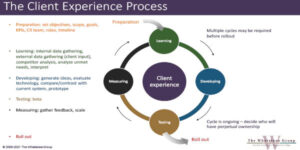Understanding and owning client experience (CX)
Do you understand the full experience your firm provides clients? From the time they begin engaging with your firm as a prospect, your clients embark on a journey with your firm. Most firms have a basic understanding of the sales process, or the proposal process, or the process of delivering a client engagement. They are often less aware of the full experience their firm provides and its cohesion—or lack-thereof. When you haven’t documented, or can’t fully articulate the experience it’s difficult to:
- Talk with a client about the value of the relationship
- Identify areas to improve
- Deliver an A+ experience that doesn’t overwhelm, over-commit and overburden your people
- Tell others what makes your CPA firm different from others
The connection between CX and brand
Most firms think of brand as the external elem
ents of communicating like logos, colors and taglines. In public accounting brand is about the attributes of service you deliver. It’s these attributes, and the way your people understand and deliver them, that differentiate one from another. Most accounting professionals are comfortable discussing the quantitative elements of client service. Did we deliver on time? Was the work accurate? Did we meet the budget? Did the deliverable look polished?
However a central, and often overlooked, component of branding is how your firm makes clients feel during their experience working with you. Therein is the root of the client experience.
In 2020 we’ve all leaned into relationships. Remote work has humanized us. Personally and professionally we’re looking for ways to connect and engage. We’re holding on hard to the relationships that add value to our lives and our business and we’re deprioritizing those that don’t. Your clients are evaluating who they trust, who they can count on, who cares, who helps with the tough stuff, who brings them ideas and solutions, and who they like to be around. Now’s the time to look at what your firm is really doing for clients and ask yourself if its special and unique enough to be a priority.
In short:
- Is your firm doing more than just the basics?
- Are clients getting more of what they need from their experience with you than they would with another firm?
- How has it changed in a remote work environment?
- What do they say about you when asked by their friends, peers and colleagues?
- Is the brand supported by non-human interactions like use of firm’s website and client portals?
Your clients’ experience – whether good, bad or indifferent— becomes your firm’s brand.
Business advisor as a differentiator – for now
The profession is talking ad nauseam about the role of business advisors—which is a key element in elevating the client experience. But if everyone is doing it (or at least, trying to do it) is it really a differentiator? In the short term, yes. Functioning business advisory practices will be differentiating as the profession continues to wrestle with both the definition of “advisory” and learning the skill. But given our accelerating pace of change and intense focus on the role of business advisors, in a relatively few number of years business advisors will evolve from being a differentiator to being table stakes. As practitioners train, apply their skills, and mentor each other business advisors will become the rule and not the exception.
Once the advisory field has been leveled what will remain will be how the people and processes in the firm make a client feel in the experience. Strategically, evaluating and enhancing client experience may be one of the most important undertakings for a firm’s future relevancy.
The illustration below the framework for a successful client experience function. It starts at the top with preparation. Often, firms need someone from the outside to help guide the project in its early phases.
Once established the middle circle of learning, developing, testing and measuring can be perpetuated to continually evaluate and refine the experience you deliver as market needs change or as the firm evolves. When the framework is established someone in the firm will need to own this ongoing as it becomes an ongoing strategic discipline in your firm. After a couple of initial cycles, your client experience will be ready for roll-out according to your plan.
A map of your client’s journey in building a relationship with your firm is a helpful deliverable of this process. Once the map is complete your leaders/project team can identify where to make improvements. The marketing team can begin to write content and materials that communicate what’s special and unique about the process for branding purposes AND how clients benefit for marketing purposes.
We’re here to help you on your journey by helping you define the scope, shepherding your team through the process, offering tools and resources to use as you go and lending and expert opinion to keep you on track.
Contact us at info@thewhetstonegroup.com to discuss how we can help.

